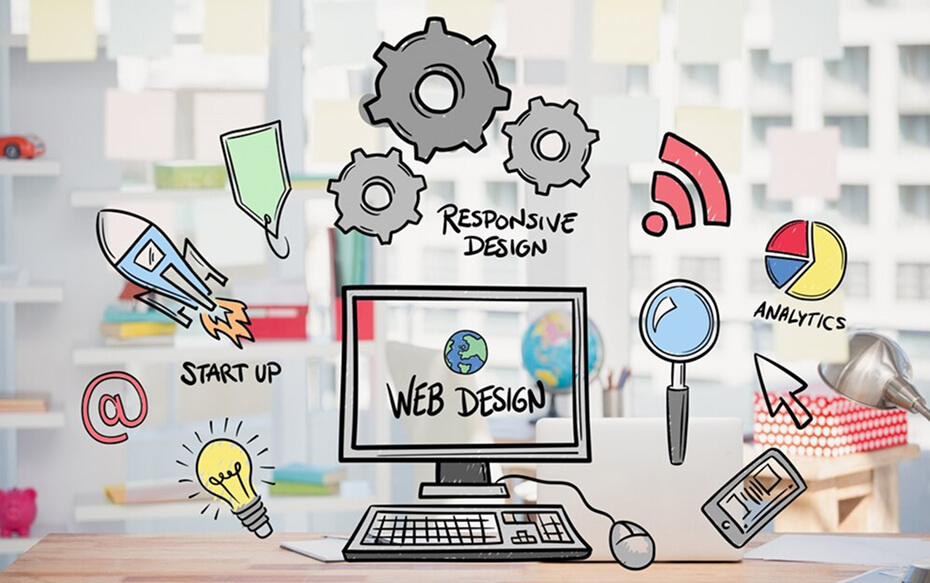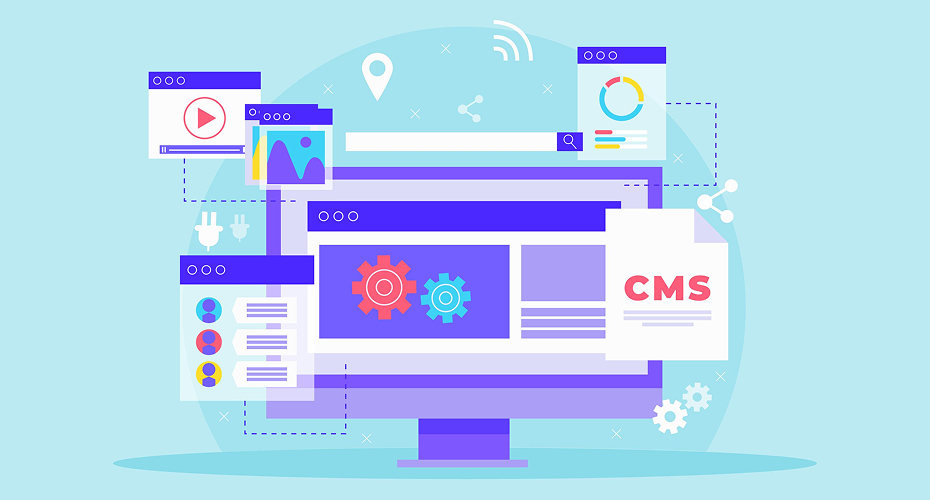Web design is evolving rapidly, blending innovation, technology, and aesthetics to create seamless user experiences. In 2025, designers are embracing trends like AI-driven layouts, immersive 3D graphics, and minimalist aesthetics to make websites more interactive and visually stunning. From dark mode to bold typography, web design trends are shaping the future of digital experiences. Whether you’re a designer, developer, or business owner, staying updated with these cutting-edge trends will help you craft compelling and user-friendly websites.
Understanding these trends is essential for building modern, engaging, and high-performing websites that captivate users and drive conversions. AI-powered elements, immersive 3D designs, and experimental typography are taking center stage, making websites more visually appealing and functional.
Top Web Design Trends
Fast loading times, data security, and easy navigation are some elements of web design trends that will never go out of style.
1. Color Trends
A major change toward digital comfort is being embraced by 2025 web design color trends. Designers are increasingly shifting toward more calming and nurturing color palettes, despite the current emphasis on striking saturated hues.
These well selected hues produce hospitable virtual environments that lessen eye strain. Designers are employing warm, rich colors to pique curiosity and organically direct consumers, so design trends are by no means becoming boring.
Don’t miss this: Applying and Understanding Color Theory in UI UX design
2. Bold Expressive Fonts
With bold, expressive typefaces that draw attention and create a distinct brand voice, typography is still evolving in web design.
Variable fonts speed up load times while providing versatile design. Serif fonts are also making a comeback in digital design, giving headlines and calls to action a more personal touch.
Designers are also adopting whimsical, unique typefaces that evoke individuality, as well as high contrast combinations of serif and sans-serif fonts. The goal of these trends is to make typography not only useful but also a crucial component of brand identity and storytelling.
3. Human Touch and Anti-Design: Designers Accept Imperfection
You must push the boundaries of anti-design, from experimental typography to cluttercore!
The anti-design 2025 web design style tends to depart from conventional wisdom and embrace unbalanced or asymmetrical layouts. It violates accepted design principles.
In 2025, the flawless, polished appearance of websites is giving way to a more genuine, human vibe.
4. Sustainable Web Design 2.0
By 2025, web sustainability will have advanced beyond simple optimization to include the development of eco-friendly websites. The reduction of digital carbon footprints is being approached more comprehensively by developers and designers.
From choosing eco-friendly hosting to optimizing media and coding for efficiency, sustainability is now a crucial component of web development.
Furthermore, in addition to being better for the environment, these methods produce speedier, more effective websites that people enjoy using.
5. Experimental Navigation
In contrast to conventional static menus and dropdowns, experimental navigation engages users with unusual layouts, fresh experiences, and unique interactions.
Immersion scrolling, captivating animations, 3D transitions, spatial interfaces, or non-linear exploration routes are all features of these designs.
These navigation patterns, which are frequently seen on creative or portfolio websites, astonish and enthrall users, promoting longer site engagement and interaction with unique content.

6. Big Blocks with Vivid Contrast
2025 web design trends are embracing the potential of striking color contrasts and strong, block-based layouts, as Canva’s website aptly demonstrates.
Businesses such as Canva serve as examples of how this design can highlight various characteristics of products or services while preserving a lighthearted, contemporary appearance.
SaaS businesses, creative platforms, and brands aiming to appeal to design-conscious consumers find this design strategy particularly successful.
7. Brutalist Design
A notable return to brutalist principles for the modern web is one of the many striking trends in web design for 2025. This trend goes against years of polished, template-driven design and is characterized by bold typography, straightforward layouts, and rough features.
Monochrome color choices, grid-based layouts, and sparse graphics are becoming popular among designers as tools for producing strong visual impact rather than as constraints.
As a result, websites that defy established design norms feel more honest, human, and paradoxically modern.
8. Motion Design
In 2025, web design trends will evolve away from overly animated and 3D features and toward more deliberate and sophisticated motion design.
This improved strategy improves site performance, lessens cognitive strain, and increases the significance of interactions when they take place. Additionally, motion improves rather than detracts from the main user experience on these websites, which feel more sophisticated and user-focused.
9. Scrolling Animations
When a visitor scrolls around a website, various animations and effects are activated, adding a dynamic and captivating element to the user experience.
This can include items that move into position, change color, or fade in and out to provide an eye-catching experience that entices visitors to keep exploring the website.
10. Micro-Interactions
When a user mouses over a link, one of the most popular micro-interactions is to watch the link change color.
To make the identical experience stand out, greater attention might be paid to micro-interactions.
As you scroll across a page, picture a gradient that gradually changes color, or imagine a pop of color that bursts from your mouse after you click.
Check this out: Reasons for the Importance of Responsive Web Design
11. Micro-Animations
When it comes to assisting users in navigating your website, micro animations are really beneficial. They can also give your website a whimsical touch, like Smashmallow’s hero image’s micro movements did.
While keeping the delicate, intentional quality that makes micro animations so powerful, these context-aware animations react to user action in an intelligent manner.
12. Emphasize Negative Space
When creating a website that prioritizes negative space, information must be carefully balanced with “white” or empty spaces to provide a simple, uncluttered look.
In order to improve readability and focus, simplicity and minimalism are essential. This allows space for buttons, photos, and text. To visually separate sections without overpowering the user, employ line spacing, padding, and margins.
13. Interactive 3D Models And Content
Additionally, products can benefit from 3D model animations, which provide a more realistic portrayal and let users see every feature from every perspective, just like they would if they were physically inspecting the item. By boosting consumer confidence and possibly raising conversion rates, this improves the online shopping experience.
Even while 3D and motion are still useful tools in web design, 2025 trends indicate a move toward more deliberate application.
14. Gamified Design
By incorporating game-like features like challenges, points, and awards into your website, you can encourage users to stay on it longer and possibly divulge personal information.
You may give visitors something of value, encourage them to participate with your site, and gain more insight about them by including interactive areas on your website.
Interactive marketing examples include:
- Exams such as quizzes
- Surveys and surveys
- Calculator
- Contests
15. Organic Shapes
Despite being a mainstay of web design since 2020, organic shapes have evolved into something more sophisticated and functional in 2025. These days, designers go beyond simple adornment to carefully incorporate flowing shapes into user interfaces and brand narratives.
Businesses are choosing deliberate, brand-aligned organic shapes over haphazard blobs in order to improve user experience and preserve aesthetic appeal.

16. Smart Video
For a long time, video has been hailed as essential to websites. Videos are popular because they are captivating, and some people would rather watch a video than read words. Videos can increase conversions and foster trust.
Video is fantastic, but it must be carefully considered. Video with meaning and purpose is what smart video is all about. We advise making educational movies that directly address frequently asked issues by your clientele and prospects.
17. Text-Only Hero Images
The “hero section” is the website version of this, and it appears at the top of a page. Using eye-catching typography in place of the usual background image in the hero section is a recent trend to grab the attention of internet users who are constantly exposed to new web sites. A strong, distinctive typeface might be the ideal way to capture a user’s attention right away.
18. Custom Illustrations
Custom graphics are back, and stock photos are going out. Illustrations help to make your business’s image come to life. It’s anticipated that custom illustrations will take the lead as generic stock visuals become less popular.
19. Dark Mode
Designs for dark mode websites have two purposes. As we spend more and more time staring at screens, they also aid to lessen eye strain, which is a worry for many. Dark mode allows you to emphasize other design features by simply darkening the surrounding elements, while also effortlessly creating an ultra-modern style for your website.
20. Data Visualization
It might be challenging to present data in an interesting way. Utilizing data visualization leverages the fact that people are visual beings and still effectively communicates your message, making the effort worthwhile.
Using your data, data visualization produces visuals that captivate your audience and compel them to read more about your company.
Some of the most often used tools for making data come to life are infographics and graphs.
Conclusion
Staying ahead in web design means embracing innovation. These cutting-edge trends redefine user experience, aesthetics, and functionality. Whether it’s AI-driven design, immersive animations, or minimalistic layouts, integrating these elements will keep your website relevant and engaging. By incorporating these trends, you can enhance user engagement, boost conversions, and create visually appealing websites. Adapt, experiment, and lead the way in creating stunning digital experiences.
InCreativeWeb – Web Design Services
Want a website that stands out? InCreativeWeb crafts stunning, high-performing websites with cutting-edge design trends. From AI-driven layouts to immersive visuals, we create user-friendly, conversion-focused sites that stand out. Our expert team ensures seamless navigation, fast performance, and innovative aesthetics. Let’s build a website that captivates and converts. Reach out to us today!
Author
Jayesh Patel
Jayesh Patel is a Professional Web Developer & Designer and the Founder of InCreativeWeb.
As a highly Creative Web/Graphic/UI Designer - Front End / PHP / WordPress / Shopify Developer, with 14+ years of experience, he also provide complete solution from SEO to Digital Marketing. The passion he has for his work, his dedication, and ability to make quick, decisive decisions set him apart from the rest.
His first priority is to create a website with Complete SEO + Speed Up + WordPress Security Code of standards.